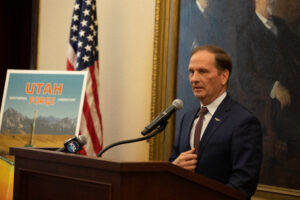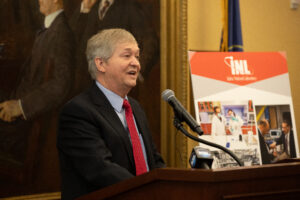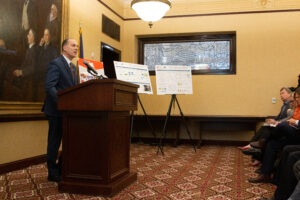
The University of Utah and Idaho National Laboratory have announced the signing of a formal agreement that allows both organizations to collaborate on research and development projects aimed at advancing the nation’s energy and security technology.
This newly signed Strategic Understanding for Premier Education and Research, or SUPER agreement, allows the organizations to explore deeper research collaborations and expand opportunities for students, faculty, and researchers. The five-year agreement solidifies what had been individual peer-to-peer agreements between laboratory researchers and university faculty members. Those will be replaced with a broad institutional memorandum encouraging greater collaboration including shared academic materials, visiting research scholars and cooperative symposia, seminars, workshops, and conferences.

The partnership was announced during a news conference Wednesday, Feb. 23, at the Utah State Capitol in Salt Lake City. Those in attendance included University of Utah President Taylor Randall, INL Director John Wagner, Utah Congressman Chris Stewart, U College of Engineering Dean Richard B. Brown, U VP for Research Erin Rothwell and members of the Utah Legislature.
“This SUPER agreement will create another inflection point in the growth of research at the University of Utah,” Brown said. “Since 2006, the College of Engineering has spun out 98 companies. The U can play a role in helping INL commercialize the technologies that come from our joint research efforts.”
The laboratory and the U’s College of Engineering already have conducted collaborative research in areas including nuclear energy, power grid security, and high-performance computing for the last decade. In 2018, INL opened an office on the University of Utah campus focused on further developing a wireless technology that grew out of one of these collaborations to help first responders and law enforcement agencies communicate time-sensitive information, even when airwaves are congested. More recently, the laboratory began collaborating with the school’s nuclear engineering faculty on a medical isotope project that could dramatically improve certain cancer treatments.

INL has also been integral in the work of the Utah FORGE project, a dedicated underground field laboratory near Milford, Utah, and sponsored by the Department of Energy. The lab is used for developing, testing, and accelerating breakthroughs in Enhanced Geothermal Systems technologies. And other engineering-related collaborations with INL researchers have included projects involving power and water systems resiliency and using machine learning in the development of a materials database.
“[The agreement] will allow our institutions to really build on what’s already been a 10-year relationship with many successes,” Wagner said.
Click below to see video of the entire press conference.
Also click below to see a video interview with Engineering Dean Richard Brown and Marianne Walck, INL’s Deputy Laboratory Director for Science and Technology, in which they detail the benefits of the new SUPER agreement.
.